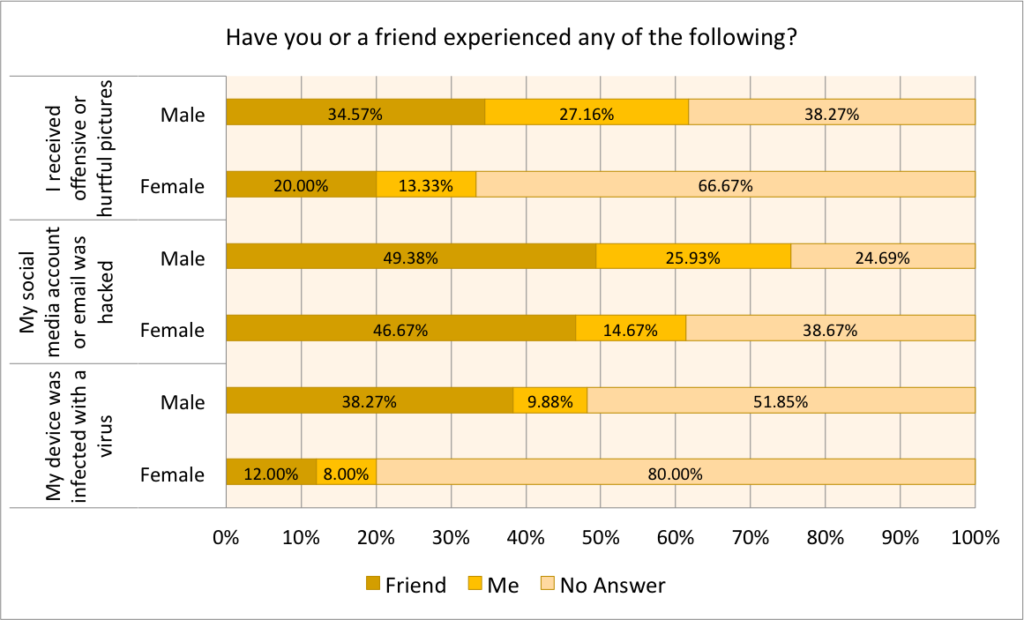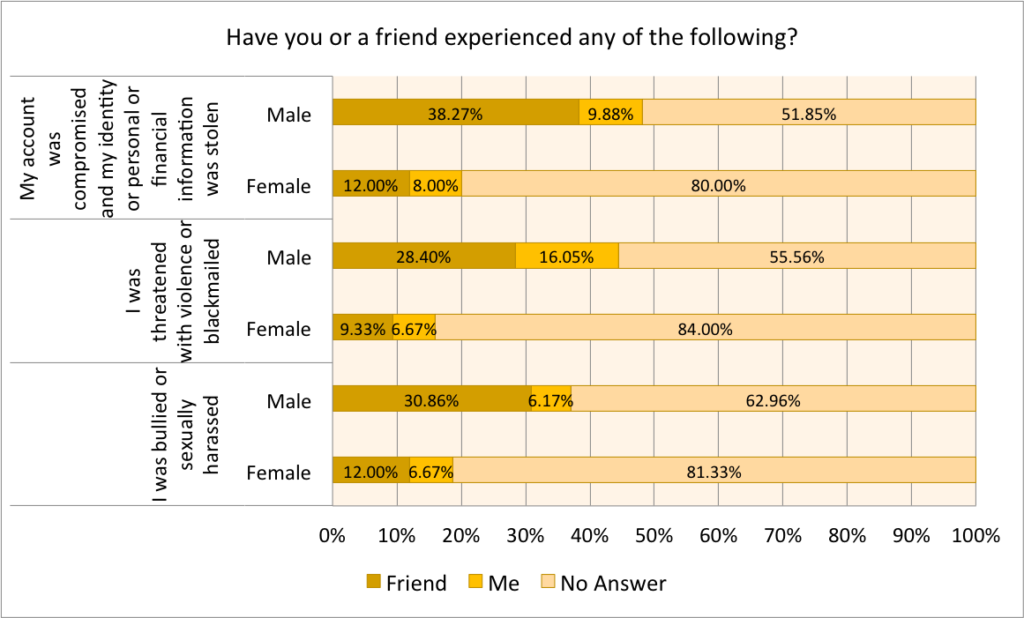Social Media Exchange (SMEX) surveyed 157 youths between the ages of 14 and 22 to develop a snapshot of how youth in Lebanon use the internet and the types of threats they face online. Our participants, from diverse backgrounds and with varying experiences, came from all eight Lebanese governorates and were split almost evenly between males and females. Nearly 10 percent were non-Lebanese, they included Syrian youth and the children of migrant workers. While by no means scientific or representative of the general youth population living in Lebanon, this survey* provides a glimpse into the online life of teenagers and young adults — as they see it. We present our findings here to begin to fill the data gap on youth and the internet in Lebanon, but do not claim that our snapshot portrays the realities of anyone beyond the 157 youth who filled out our questionnaire.
Internet Access and Usage
The vast majority of those surveyed — 93 percent — use a mobile phone most frequently to access the internet. A shared desktop or laptop (be it at school, home, or an internet cafe) came in second at 54 percent, followed closely by a personal computer with 50 percent.
Nearly 11 percent do not have access to a data-enabled phone and rely on Wi-Fi instead to access the internet.
Most respondents reported using Android operating systems on their smartphones and Windows on their computers. Their preferred browser is Google Chrome, with 82 percent indicating its use. Trailing behind is Internet Explorer with only nine percent.
 The three most frequently visited websites are social media platforms Instagram, Snapchat, and Facebook, with high frequency defined as either daily access or recurring weekly access. Video-sharing site YouTube was the youth’s fourth most frequently visited website, with 51 percent reporting its frequent access. In our data analysis, we did not note any stark differences between the sites accessed by males vs. females. In certain instances, such as Twitter, both groups reported low use (with 86 percent of the former and 87 percent of the latter indicating they never visit the site).
The three most frequently visited websites are social media platforms Instagram, Snapchat, and Facebook, with high frequency defined as either daily access or recurring weekly access. Video-sharing site YouTube was the youth’s fourth most frequently visited website, with 51 percent reporting its frequent access. In our data analysis, we did not note any stark differences between the sites accessed by males vs. females. In certain instances, such as Twitter, both groups reported low use (with 86 percent of the former and 87 percent of the latter indicating they never visit the site).
Parental Involvement and Influence
Parents or parental figures who are involved in their children’s online presence and activities are in the minority. In response to, “How involved are your parents in your online activities?” we gathered that 38 percent can access anything they want, whenever they want, and for as long as they choose. Seventy-eight percent noted that their parental figures do not have an administrative account that allows them to control which programs they use on their computers or any other devices.
On the other hand, 47 percent indicated that their parents have rules in place, but do not actively monitor them. Nearly 13 percent reported that their parents are enrolled in a parental control service that allows them to block their access to websites they deem inappropriate or offensive (such as OGERO’s “Parental Protection” service).
Attitudes
The most striking difference in attitude toward online privacy was along gender lines, not geographic location, or age, or any other marker. We found that 46 percent of female participants are concerned about their online privacy, versus just 26 percent who are not. Conversely, 50 percent of male participants indicated a lack of concern, versus just 26 percent who do have some worry.

Asked to assess how much importance they attach to their online reputation, we ranked the youth’s answers as high (of crucial importance); medium (of some importance); and low (of no importance at all). The responses were as follows, 59 percent reported high importance; 17 percent marked medium; and 22 percent noted low.
Leaks by former National Security Agency contractor and whistleblower Edward Snowden — revealing the existence of a global surveillance system — launched an international debate on privacy in 2013. We were interested in knowing if these debates and others on privacy and surveillance had reached youth in Lebanon. We asked them if they are concerned about being monitored online. The majority — 56 percent — indicated that they did not believe anyone was monitoring their activities on the internet. Those who did express concern about online surveillance regarded the government as its source, at 19 percent, and family members and siblings, at 15 percent. A very small percentage (four percent) told us they worry about being monitored by private companies and marketers.
Practices
In terms of highlighting potential security risks, we wanted to know how much personal information is being shared by youth online.
We found that nearly 40 percent of those polled share their home or school address. The vast majority — 86 percent — share their real name and nearly 33 percent list their phone number online. We found it interesting that while individuals who reported having shared their exact location at some point in the past were in the minority — 28 percent of females and 33 percent of males — even fewer (8 percent) were aware that their phones might be reporting their location without their knowledge. This illustrates the dissonance between the youth’s perceived and real levels of knowledge. On the other hand, very few reported having shared revealing, intimate, or potentially compromising personal photos, or any of their financial information. As for political and religious views, only 19 percent say they share them on online platforms.
As for their practices to mitigate risks faced online, we found that — across the board — youth who are familiar with or regularly use tools to secure their communications and protect their privacy are in the minority. Only 11 percent use software that allows for anonymous communication, such as Tor. Slightly over 13 percent have downloaded browser add-ons to block spying ads and online trackers. Less than 13 percent have strict privacy settings and/or use 2-step verification for their online accounts.
The most widely used method to safeguard their personal information on their phones is passcodes, with nearly 55 percent of the participants reporting their use on their devices.
We found out that while many youth share their desktop or laptop with others in their household or at school, only 22 percent of those surveyed reported logging out of their accounts and deleting their browsing history after using a shared computer. Finally, nearly 15 percent shared that they have never been proactive in any way to safeguard their privacy.
Experiences

The two charts (above and below) indicate the prevalence of hacking; cyberbullying; threats of violence and blackmail; receipt of offensive, hateful, or profane comments and/or pictures.

SMEX regards digital safety as an ongoing and regularly evolving practice, rather than a one-time activity. We intend to use the data collected through this survey — in combination with other available data — to create a comprehensive program that offers a review of digital security, rights, and literacy.
*This survey was conducted as part of a three-month digital safety and privacy project in Lebanon, implemented by SMEX, in collaboration with the Higher Council for Childhood of Lebanon’s Ministry of Social Affairs, from October 1 through December 31, 2016. It was supported by DW Akademie. The project, “Your Privacy is Your Responsibility” encompassed 10 digital safety trainings and an awareness-raising campaign on the importance of protecting personal data (Ar) that included a guide (Ar) to avoid becoming a victim of sextortion (Ar) and tips to maintain one’s privacy online.


